Lecture 36: Ureters, Urinary Bladder, and Urethra
1/77
There's no tags or description
Looks like no tags are added yet.
Name | Mastery | Learn | Test | Matching | Spaced |
|---|
No study sessions yet.
78 Terms
what is the tubular continuation of the renal pelvis that enters the urinary bladder wall obliquely?
ureters
the ureters are covered by
a mucosal flap called the vesicoureteral valve
what does the vesicoureteral valve do?
prevents reflux of urine from the bladder back into the ureter
what lines the ureters?
pseudostratified transitional epithelium that is normally smooth and glistening
what is the function of the ureters?
propel urine from renal pelvis to bladder via peristalsis
urinary bladder
expansile, muscular sac
normal mucosa is smooth and glistening
urine should be translucent
why is urine cloudy in horses?
the abundant excretion of calcium in the form of calcium carbonate crystals and mucus produced in renal pelvis and proximal ureter
what is the function of the urinary bladder?
store and expel urine
what is continence in the urinary bladder?
detrusor muscle relaxed and leakage prevented by activated urethral sphincter and contraction of urethral muscles
what is micturition?
contracted detrusor muscle moves urine through relaxed urethra
what is the tubular continuation of the urinary bladder that directs urine out of the body?
urethra
why are females predisposed to ascending UTIs?
they have a relatively short urethra
why do males have higher risk of lower urinary tract obstructions?
their urethra travels a more elongated course
in all male animals, the urethra courses over the ischial arch, which may result in
narrowing of the luminal diameter and potentially allows obstructions to form
where is a common location for obstructions in ruminants/pigs?
sigmoid flexure
where is an area of obstruction in dogs?
os penis
what is a common location of obstruction in small ruminants?
the narrow urethral process extending from the tip of the glans penis
what is the most common source of disease in the urinary system?
obstruction of flow → pressure necrosis
infectious causes leading to inflammation
accumulation of toxic metabolites can result in infection, hyperplasia, metaplasia, or neoplastic transformation
ascending infection of urinary system
contamination for GI, skin or repro tract
blind ended tubular system with one exit → predispose to bacterial ascension
more adherent bacteria may ascend to renal pelvis via vesicoureteral reflux
urine stasis and infrequent urination can predispose to disease
descending infection of urinary system
from kidney/renal pelvis
how is exposure from lumen considered a portal of entry?
toxin accumulation or trauma from urolith
what are defense mechanisms of the urinary system?
flushing action of urine minimizes risk for bacterial adherence
peristalsis that eliminates bacteria
inhospitable environment for bacterial growth controlled by urine pH and osmolarity
protective urothelial mucus coating
innate and humoral immune response
where should an ectopic ureter terminate?
in trigone on urinary bladder
true or false: ectopic ureters are more predisposed to obstruction or infection.
true
ectopic ureters may present with
incontinence or urine dribbling
predisposed breeds to ectopic ureters
labs, huskies, westies, fox terrier, mini and toy poodles
patent urachus is most commonly seen in
foals
what is the urachus?
tube in umbilical cord that drains urine from fetal bladder to allantoic sac in placenta
what happens if the urachus fails to close?
can dribble urine from umbilicus, susceptible to ascending infection
the urachus is the direct channel between
urinary bladder and umbilicus
true or false: patent urachus is the most common malformation of urinary bladder.
true
hydroureter
dilation of the ureters
most often caused by obstruction of urine outflow because of blockage of the ureters by calculi, chronic inflammation, lumina or intramural neoplasia, or accidental partial ligation
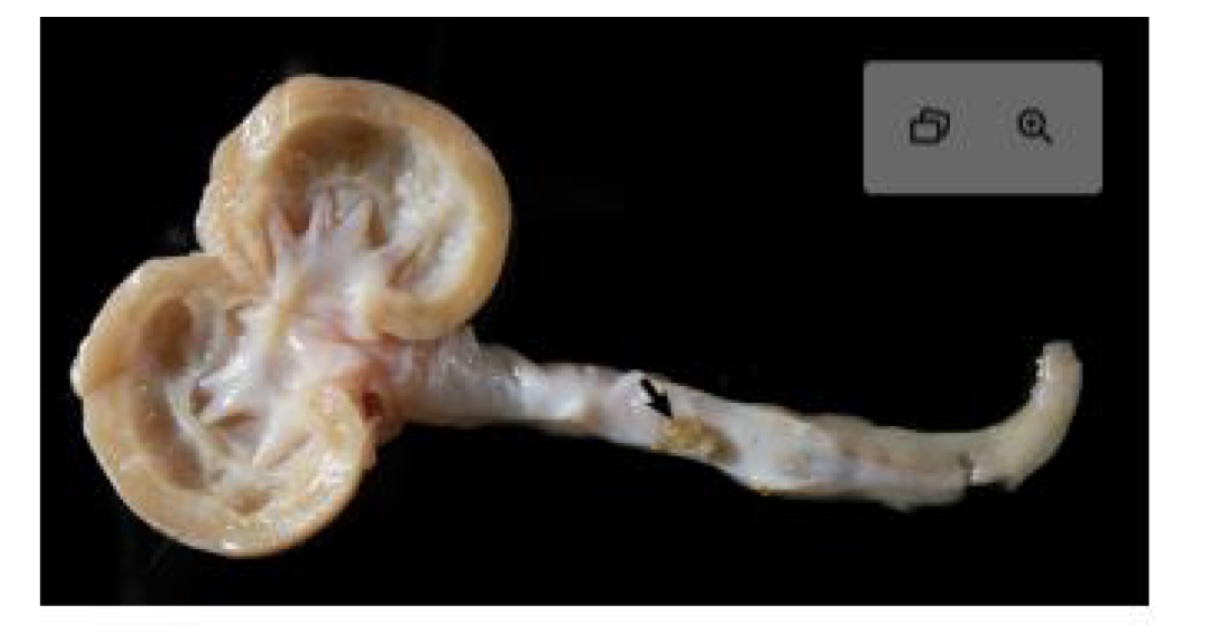
what is this arrow pointing to?
calculus in ureter lumen
what is urolithiasis?
presence of stones or calculi (uroliths) in the urinary collecting system
when do uroliths form?
when genetic, dietary, and pathophysiologic factors occur together and cause the precipitation of excretory metabolites in urine into grossly visible stones
uroliths are least common in the
renal pelvis
urinary pH
oxalates precipitate at acid pH
struvites and carbonates precipitate at alkaline pH
what are urinary calculi?
aggregations of precipitated mineral admixed with urinary proteins and proteinaceous debris
silica calculi
have a unique, pronged appearance that resembles jacks
large renal pelvic calculi classically have a
staghorn appearance
what are urinary calculi composed of?
fine, sandlike material, which causes cloudy urine
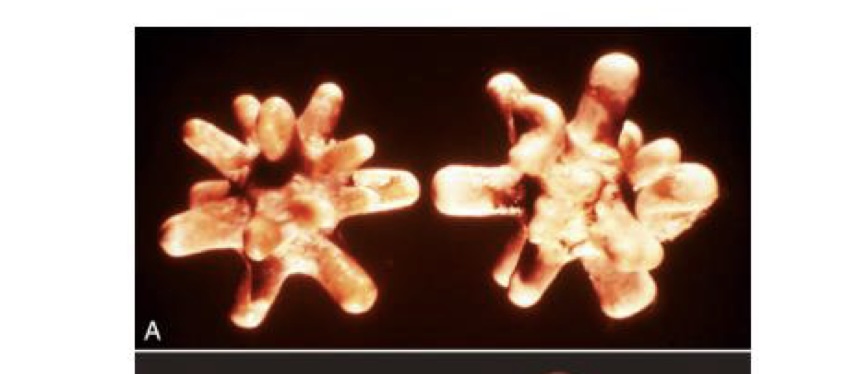
what type of calculi is this?
silica calculi (jacks)
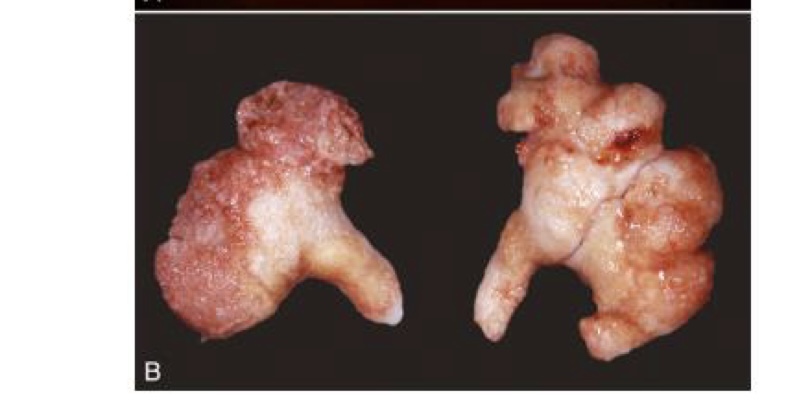
what type of calculi is this?
staghorn
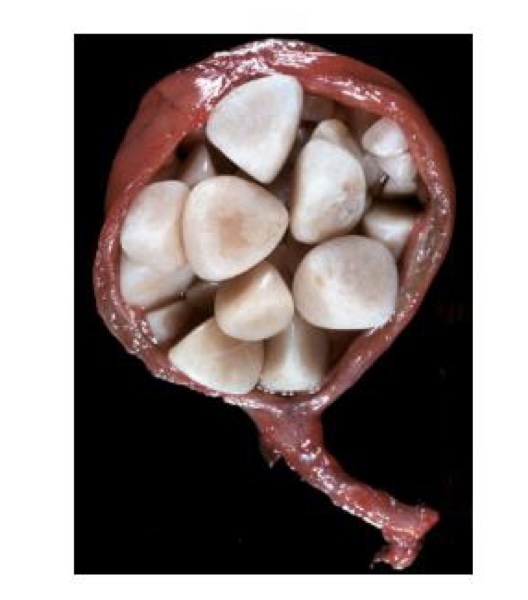
what type of calculi is this?
smooth struvite
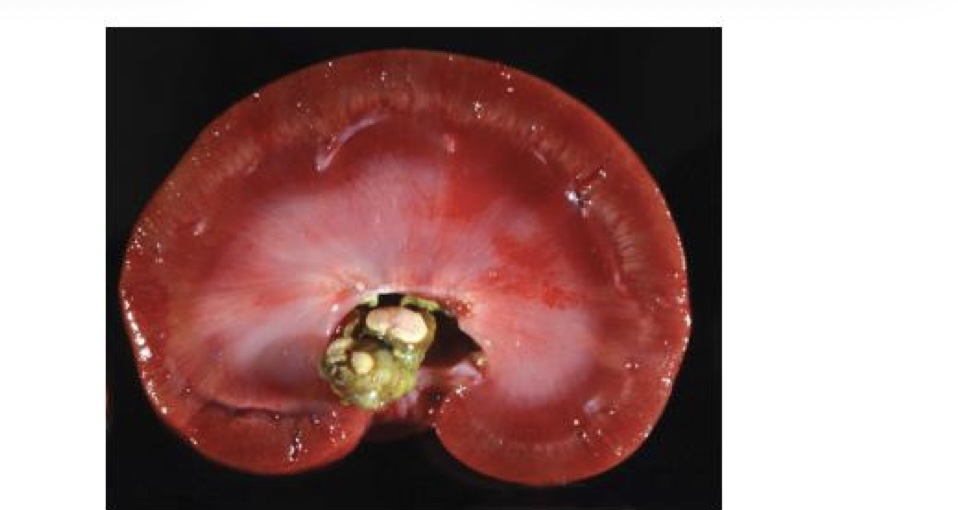
what type of calculi is this?
ammonium biurate calculi
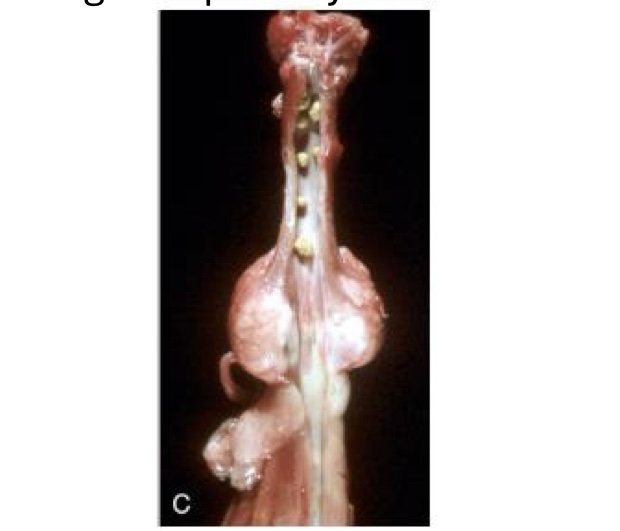
what type of calculi is this?
calculi in penile urethra of cat
male cats with urinary obstruction
urethral plugs → fine struvite (sand) with rubbery protein matrix can occlude urethra leading to obstruction
female cats with urinary obstruction
more often calculi leading to obstruction in urinary bladder or renal pelvis
what is the most common kind of crystal in dogs historically?
struvite → possibly diet related
what is the more common calculi in dogs?
calcium oxalate → can be seen with cushings, hyperparathyroidism, hypercalcemia or exogenous steroids
what calculi is more common in dalmations because they excrete high concentrations of uric acid?
urate stones
urate stones are an autosomal recessive trait resulting in
incomplete conversion of uric acid to allantoin
urolithiasis in ruminants
silica and struvite can cause obstructions most often in bulls and steers at the sigmoid flexure
severe cases - rupture from accumulation of urine
acute cystitis
bacterial infection is the most common cause
E. coli is the most common implicated bacteria across species
more common in females
why is the bladder resistant to infection?
because of the flushing action of normal urine flow that quickly removes contaminating material
factors that promote bacterial colonization in urinary bladder
bacteria
host → decreased urination, urine retention, immune suppression
disruption of urothelium
bacteria growth enhanced if glucosuria
what are the 3 different forms of chronic cystitis
diffuse, follicular, polypoid
diffuse chronic cystitis
mucosa reddened and thickened
follicular chronic cystitis
nodules white-gray nodular proliferations bordered by hyperemia (cobblestone appearance)
most common in dogs
most common with accompanying urolithiasis
polypoid pattern of chronic cystitis
polyps arising in the bladder mucosa are composed of a core proliferative connective tissue covered by surface epithelium and mononuclear inflammation
polypod pattern of chronic cystitis is what kind of response?
inflammatory/hyperplastic
mycotic cystitis
candida albicans
aspergillus sp.
secondary to chronic bacterial cystitis/immune suppression
prolonged antimicrobial therapy
feline idiopathic cystitis
common cause of feline lower urinary tract disease
more common in middle aged, overweight, male indoor cats
lesions nonspecific
canine cystitis
cyclophophamide induced hemorrhagic cystitis
cantharidin hemorrhagic cystitis
horses
ingestion of blister beetles from hay or contaminated products
beetles contain cantharidin
hemorrhagic erosive cystitis
GI ulceration and colitis
bracken fern cystitis
hematuria that can be associated with neoplasia
chronic ingestion of bracken fern
all parts of fern are toxic
what is the principle carcinogen within bracken fern?
ptaquiloside
neoplasia
most common in bladder
most common in dogs, occasionally in cats, rare in other species
scottish terriers, shetland sheepdogs, beagles and collies increased risk
what % of tumors are epithelial tumors?
80%
papillomas
multiple and may have a pedunculated or sessile appearance
composed of well-differentiated urotehlium
urothelial cell carcinomas
focal, raised nodules or diffuse thickenings of the urinary bladder wall
most common in the trigone region of the bladder
in cats, urothelial cell carcinomas tend to arise
at sites in the bladder distant from the trigone
squamous cell carcinomas and adenocarcinomas
small portion of bladder neoplasms
less likely to metastasize than urothelial carcinomas
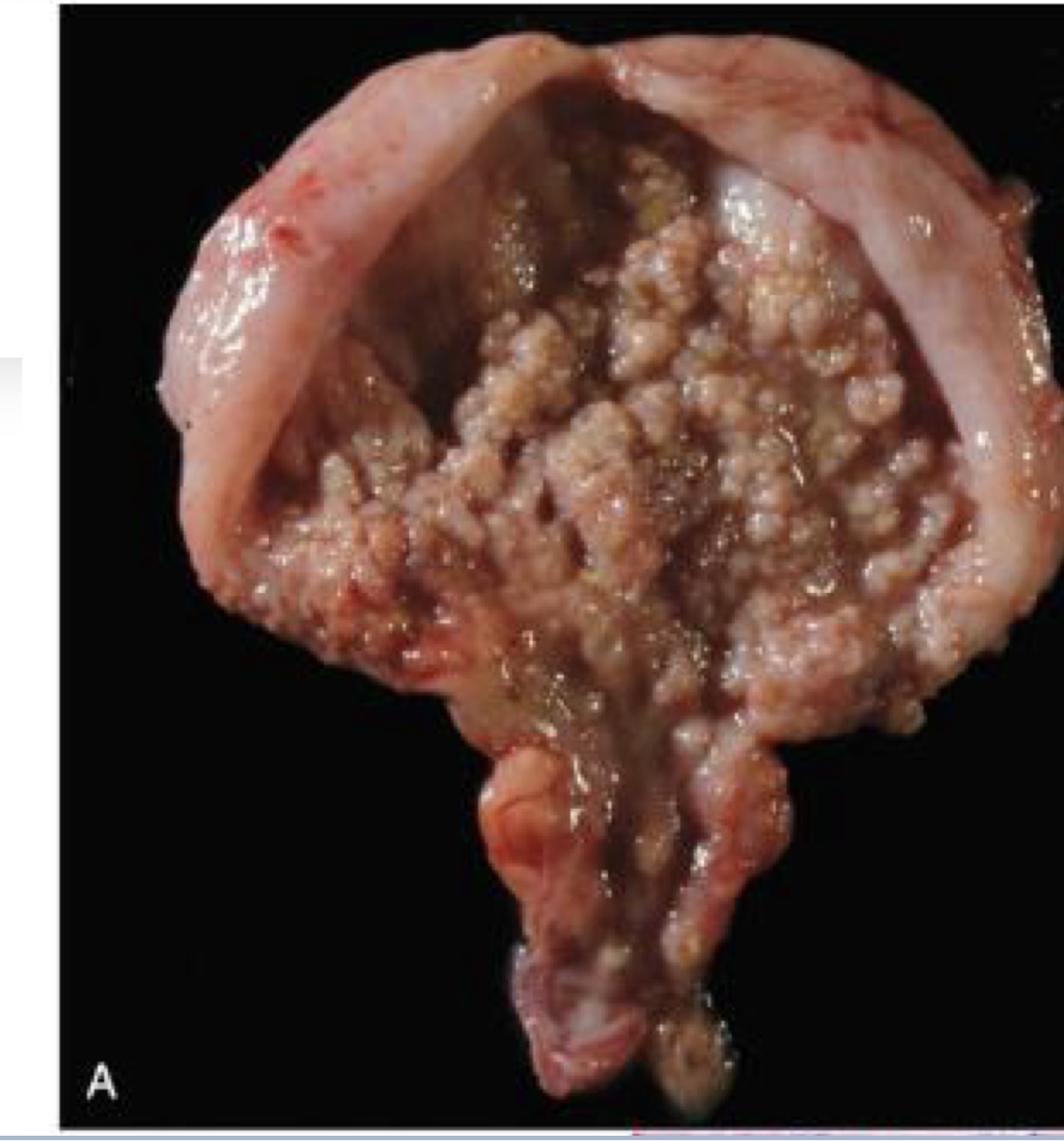
what is this picture showing?
urothelial carcinoma in dog → multilobulated mass protruding into lumen
mesenchymal tumors
fewer than 20% of neoplasms
leiomyoma
fibroma
rhabdomyosarcoma
lymphosarcoma
hemangiosarcoma
what is one of the best models of toxic induced neoplasia in vet med?
bracken fern neoplasia
cattle chronically ingesting bracken fern can have incidence of neoplasia up to
25%
where is bracken fern neoplasia most commonly located?
on ventral and lateral bladder wall due to more frequent contact with toxic metabolites in the urine